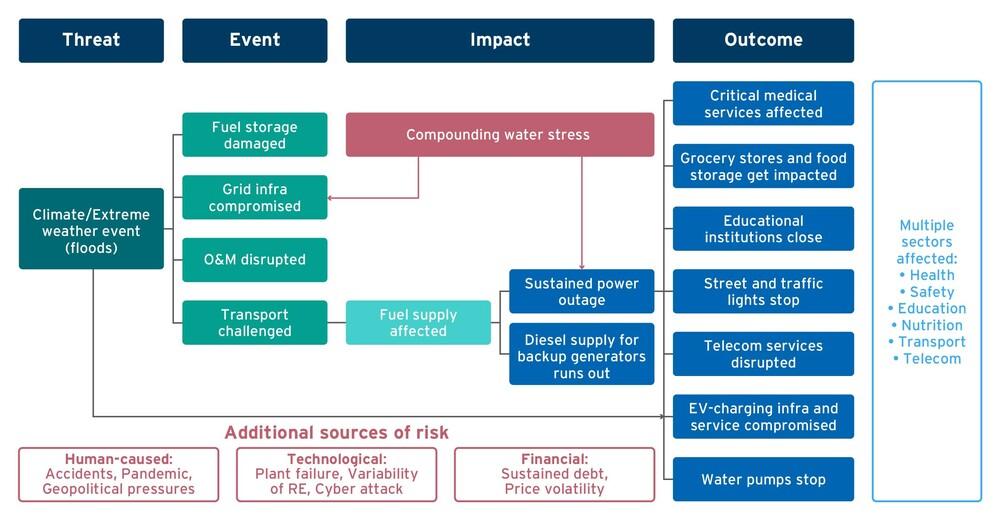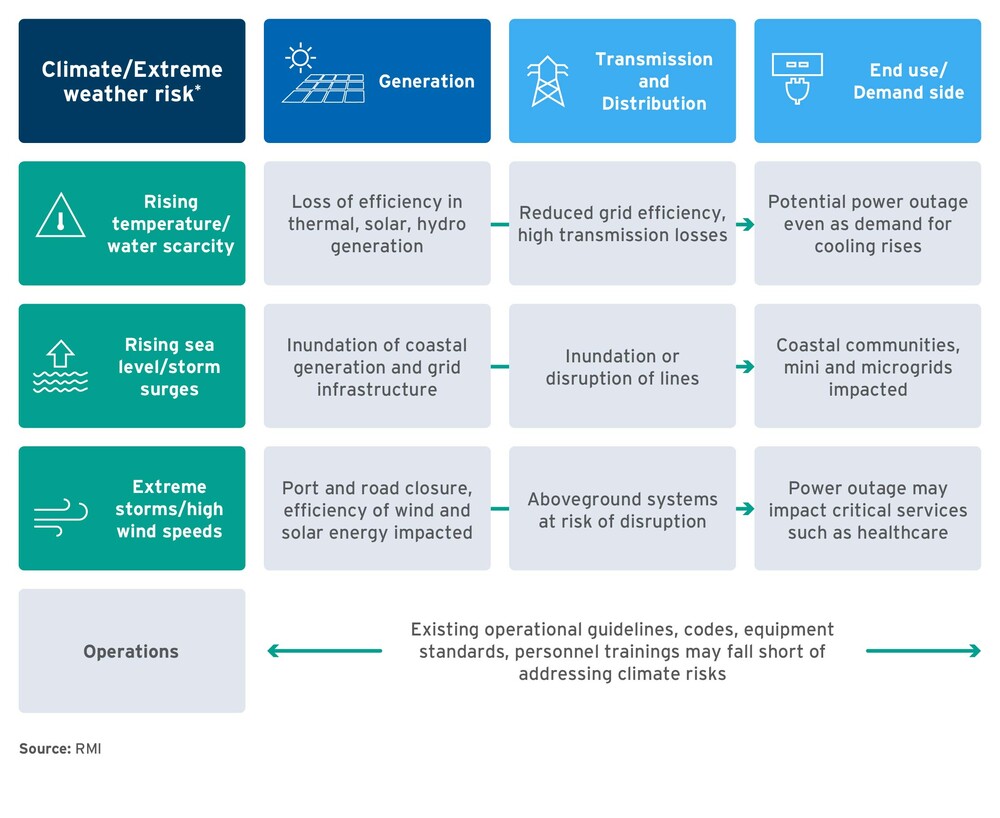
Weathering Climate Risks
Toward a Climate Resilient Power Sector in India
Resilience is a system’s ability to plan and prepare for, absorb, recover from, and adapt to adverse events over time. To that extent, resilience is a complementary attribute to risk management since it uses strategies not just to mitigate, but also to adapt and learn. Climate risks with their long-term, uncertain, and evolving nature make anticipation and proactive response to a disruption challenging. This makes resilience planning even more important. Without resilience planning, climate change threatens the pace of the energy transition, in addition to affecting overall energy security and the social benefits that clean energy affords.
With electrification being front and center of the global energy transition, the power sector has become central to climate action. Increasing electrification means that the power sector will progressively support newer sectors such as transportation and cooking, in addition to critical services such as health, education, telecom, financial services, and more. The vulnerability of the grid to climate change and extreme weather events will no longer be confined to the electricity value chain. It is bound to be compounded across the whole economy, potentially imposing high social and economic costs.

This vulnerability also extends to the pace of renewable energy adoption. Extreme weather events do not just increase the cost of heavy physical infrastructure (for both fossil fuel and renewable-based systems), but also negatively impact generation and operational efficiency. For example, in India, the need for climate resilience of the power sector is heightened because of factors such as rising heat and water stress as well as extreme weather events like cyclones and floods. Such external disruptions pose both physical and operational risks and increase electricity demand along with increasing dependence on the electricity grid.
The associated uncertainty of climate risks also makes accurate renewable forecasting difficult, posing challenges to grid integration of variable renewable energy sources. As such, mainstreaming climate resilience in our energy transition and electricity infrastructure planning must take center stage in the coming decade.
It is important to note that resilience thinking acknowledges both structural (physical electricity infrastructure) and non-structural (policy, regulation, data, technology, communication, management, etc.) aspects of the sector. Therefore, building resilience against climate risks requires upgrades across power sector-associated governance, management, technology, infrastructure, and finance paradigms.
Key Strategies of Resilience Planning
Redefining Infrastructure and Equipment Standards
Before a disruptive event, the overarching governance, regulatory, and procurement processes should be readied by redefining infrastructure and equipment standards and specifications. This includes leveraging the existing disaster management framework for the power sector and implementing newer, customized plans and frameworks that look beyond legacy climate risks.
Taking a Bottom-Up Approach
At the same time, given the benefits of decentralized energy resources (DERs) in extending access and reliability of supply to towns and villages, a bottom-up approach in power sector planning can help acquire lessons from local contexts, risks, and response strategies. Training locals to operate, maintain, and repair infrastructure may work to reduce lead times in responding to and recovering from any disruption.
Adapting Market Design
On the other hand, the market design needs to adapt to the changing risk scenario as well. The recent draft National Electricity Policy 2021 released by the Ministry of Power supports the promotion of renewable-powered minigrids, islanding of systems into microgrids, and using hydro and hydrogen storage to balance electricity load. It also calls for distribution service aggregators. The Central Electricity Regulatory Commission has drafted ancillary services market regulations that allow energy storage and demand response to participate in the market. These are welcome signs from the point of view of system flexibility and reliability—making DERs more viable and contributing to resilience building.
Using Granular and Accessible Climate Data
However, effective governance and management requires granular and accessible climate data in a format that is digestible by power sector planners and utilities. On the end-use side, access to relevant electricity data can enable users to respond to disruptions by changing use patterns. It follows from this that to make the electricity system more nimble, the entire value chain could use a technological and infrastructural upgrade.

Using Advanced Technologies
Technologies enabled by digitalization such as asset management tools and digital twinning, along with introducing redundancy and islanding capabilities in the system, can help prevent systemwide disruptions. For example, India has the largest operating synchronous grid in the world. And while this offers flexibility, it is also at risk from systemwide failures. The linearity of the power system further enables disruptions to cascade down the value chain. At the same time, two or more disruptions can coincide and affect different components of the electricity ecosystem.
The transmission and distribution (T&D) system specifically can prevent cascading disruptions through adoption of DERs and innovation in battery storage. Non-wire alternatives like virtual power lines can take advantage of utility-scale batteries at the generation and demand end to manage load on congested T&D networks. These can also offer ancillary services and help facilitate variable renewable energy integration onto the grid. Other measures such as use of advanced renewable energy forecasting and advanced metering infrastructure can enable distribution companies to cut costs and identify areas of disruptions to provide swift response.
Enacting Resilience Pricing
Finally, pricing resilience needs to assume importance to give cash-strapped utilities an indication of both the necessary costs to undertake resilience building measures, and the potential savings, or costs avoided, due to these interventions. The familiarization of the financial sector to long-term climate risks can help in the provision of appropriate financial instruments for the power sector and introduce climate risk screening in authorizing funds for developers. Other market-based instruments such as bonds, insurance, and international climate and energy finance can also be explored for financing.
Resilience thinking enables a proactive, forward-looking, and iterative approach to planning. The whole stakeholder ecosystem of the power sector must come together to understand the nuances of the unprecedented challenges that climate risks pose to the sector. Most importantly, resilience thinking must be integrated into established structures and methods if India is to truly achieve its clean energy and development ambitions.
Download Powering Through: A Climate Resilient Future: Recommendations for the Indian Power Sector
Jagabanta Ningthoujam is a Manager with RMI India. He works on electricity, hydrogen and battery related work streams.
Nuvodita Singh is an Associate at RMI India. She works on electricity sector decarbonisation and energy systems resilience in India.